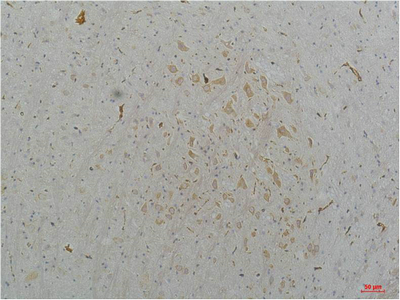Cav2.2 Polyclonal Antibody
- Catalog No.:YN5641
- Applications:IHC;IF
- Reactivity:Human;Rat;Mouse
- Target:
- Cav2.2
- Fields:
- >>MAPK signaling pathway;>>Calcium signaling pathway;>>Synaptic vesicle cycle;>>Retrograde endocannabinoid signaling;>>Cholinergic synapse;>>Serotonergic synapse;>>GABAergic synapse;>>Dopaminergic synapse;>>Type II diabetes mellitus;>>Huntington disease;>>Prion disease;>>Pathways of neurodegeneration - multiple diseases;>>Morphine addiction;>>Nicotine addiction;>>Chemical carcinogenesis - receptor activation
- Gene Name:
- CACNA1B
- Protein Name:
- Voltage-dependent N-type calcium channel subunit alpha-1B (Brain calcium channel III) (BIII) (Calcium channel, L type, alpha-1 polypeptide isoform 5) (Voltage-gated calcium channel subunit alpha Cav2.
- Human Gene Id:
- 774
- Human Swiss Prot No:
- Q00975
- Mouse Swiss Prot No:
- O55017
- Rat Swiss Prot No:
- Q02294
- Immunogen:
- Synthetic Peptide of Cav2.2 AA range: 230-310
- Specificity:
- Cav2.2 protein(A205) detects endogenous levels of Cav2.2
- Formulation:
- Liquid in PBS containing 50% glycerol, 0.5% BSA and 0.02% sodium azide.
- Source:
- Polyclonal, Rabbit,IgG
- Dilution:
- IHC 1:50-100. IF 1:50-200
- Purification:
- The antibody was affinity-purified from rabbit antiserum by affinity-chromatography using epitope-specific immunogen.
- Concentration:
- 1 mg/ml
- Storage Stability:
- -15°C to -25°C/1 year(Do not lower than -25°C)
- Other Name:
- Voltage-dependent N-type calcium channel subunit alpha-1B (Brain calcium channel III;BIII;Calcium channel, L type, alpha-1 polypeptide isoform 5;Voltage-gated calcium channel subunit alpha Cav2.2)
- Observed Band(KD):
- 263kD
- Background:
- calcium voltage-gated channel subunit alpha1 B(CACNA1B) Homo sapiens The protein encoded by this gene is the pore-forming subunit of an N-type voltage-dependent calcium channel, which controls neurotransmitter release from neurons. The encoded protein forms a complex with alpha-2, beta, and delta subunits to form the high-voltage activated channel. This channel is sensitive to omega-conotoxin-GVIA and omega-agatoxin-IIIA but insensitive to dihydropyridines. Two transcript variants encoding different isoforms have been found for this gene. [provided by RefSeq, Aug 2011],
- Function:
- domain:Each of the four internal repeats contains five hydrophobic transmembrane segments (S1, S2, S3, S5, S6) and one positively charged transmembrane segment (S4). S4 segments probably represent the voltage-sensor and are characterized by a series of positively charged amino acids at every third position.,function:Voltage-sensitive calcium channels (VSCC) mediate the entry of calcium ions into excitable cells and are also involved in a variety of calcium-dependent processes, including muscle contraction, hormone or neurotransmitter release, gene expression, cell motility, cell division and cell death. The isoform alpha-1B gives rise to N-type calcium currents. N-type calcium channels belong to the 'high-voltage activated' (HVA) group and are blocked by omega-conotoxin-GVIA (omega-CTx-GVIA) and by omega-agatoxin-IIIA (omega-Aga-IIIA). They are however insensitive to dihydropyridines (DH
- Subcellular Location:
- Membrane ; Multi-pass membrane protein .
- Expression:
- Isoform Alpha-1b-1 and isoform Alpha-1b-2 are expressed in the central nervous system, but not in skeletal muscle or aorta. Expressed in the cerebral white matter, cortex, hippocampus, basal ganglia, and cerebellum (PubMed:30982612).
- June 19-2018
- WESTERN IMMUNOBLOTTING PROTOCOL
- June 19-2018
- IMMUNOHISTOCHEMISTRY-PARAFFIN PROTOCOL
- June 19-2018
- IMMUNOFLUORESCENCE PROTOCOL
- September 08-2020
- FLOW-CYTOMEYRT-PROTOCOL
- May 20-2022
- Cell-Based ELISA│解您多样本WB检测之困扰
- July 13-2018
- CELL-BASED-ELISA-PROTOCOL-FOR-ACETYL-PROTEIN
- July 13-2018
- CELL-BASED-ELISA-PROTOCOL-FOR-PHOSPHO-PROTEIN
- July 13-2018
- Antibody-FAQs
- Products Images

- Immunohistochemical analysis of paraffin-embedded Mouse Brain Tissue using Cav2.2Rabbit pAb diluted at 1:200.



